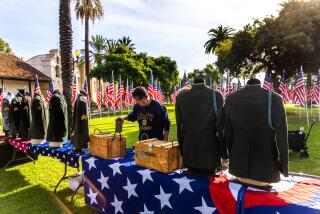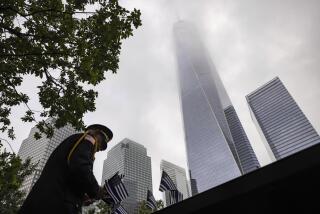Sept. 11 Exhibit at Police Museum Salutes Some of New York’s Finest
- Share via
NEW YORK — While city officials, relatives of victims of the Sept. 11 terrorist attacks and others continue debating how best to honor the dead at ground zero, a low-key museum on the other side of Lower Manhattan already has completed a memorial to its family.
The New York City Police Museum, in an ornate former precinct house in the Financial District, last week opened a permanent exhibit dedicated to the 23 city officers killed in the terrorist attack.
The display helps document the New York Police Department’s role during and after the tragedy, a role that may be less well understood than that of the Port Authority Police Department, which had its headquarters at the World Trade Center, or the New York City Fire Department; both of those agencies suffered far greater loss of life.
Titled “9.11 Remembered,” the exhibit includes a fast-moving, multimedia presentation on two sets of flat screens set up to resemble the twin towers. There are a number of previously unseen interviews with dispatchers, supervisors and street cops on the scene of the disaster.
Equally poignant is the silent testimony provided by such recovered artifacts as a battered leather holster, a set of keys and badge No. 10467, all belonging to Officer Moira Ann Smith, the lone policewoman killed in the collapse of the towers.
Next to Smith’s equipment is a picture from the New York Daily News that shows her leading a bleeding man in a business suit away from the burning towers. Smith, the mother of a 2-year-old girl, perished when she returned to help others.
Another officer who died that day was John W. Perry, a lawyer who spoke several languages and was assigned to Precinct 40 in the Bronx, about as far from the World Trade Center as you can get and still be in New York City.
But on Sept. 11, 2001, Perry was at police headquarters in Lower Manhattan, filling out paperwork: his retirement papers. It was his last day on the job, as he prepared for a new career as a full-time attorney.
When the first emergency calls came in, Perry, a marathoner, sprinted out of the station to ground zero. He was last seen helping another officer assist a civilian outside the skyscrapers. Both the civilian and the other officer survived. That story does not appear in any display, but was told by Michael Cronin, the museum’s deputy director, who was friends with Perry during Cronin’s own 20 years with the NYPD.
“If there was anything good to come out of it,” Cronin said of the attacks, “it kind of turned sentiment around” -- improving the NYPD’s typically tense relationship with residents here. “There was a massive outpouring of support afterward.”
The Sept. 11 exhibit is just one part -- albeit a big one -- of the police museum. Until a few years ago, the museum consisted of a few display cases squirreled away in the police academy. Now it occupies a 1911 building modeled after an Italian palazzo that for many years served as headquarters for the 1st Precinct.
New police recruits tour the museum as part of their curriculum. Display cases contain items such as wooden rattles, which served as alarm bells for 17th century officers back when Manhattan was a Dutch colony, and photos of Victorian-era cops with handlebar mustaches, as well as zip guns, brass knuckles, machetes and crude hand grenades -- some of the workplace hazards encountered by officers in earlier eras.
One afternoon last week, Los Angeles Police Officer Tae Kim was touring the museum while visiting family in Manhattan, where he grew up.
Kim, somber as he looked over photos of the jagged wreckage at ground zero, recalled seeing the tragedy unfold on TV that morning and thinking, “Is this a movie I’m watching?”
The NYPD provided victim assistance outside the World Trade Center and crowd control in the chaotic aftermath, calling on many academy recruits to direct traffic and conduct patrols in more distant parts of the city. But the most stressful role may have been that of the forensic experts who for months afterward sifted through the rubble that was trucked to a landfill.
A 9-year-old whose crayoned letter is one of many on display in the museum showed a precocious understanding of that difficult task.
“Dear Police and Medical Examiners,” she wrote. “Don’t give up. I have faith in you. I just wanted to encourage you to keep going. I feel sad that you might even have to identify some of your friends that you lost. Love, Gina G.”
More to Read
Sign up for Essential California
The most important California stories and recommendations in your inbox every morning.
You may occasionally receive promotional content from the Los Angeles Times.













